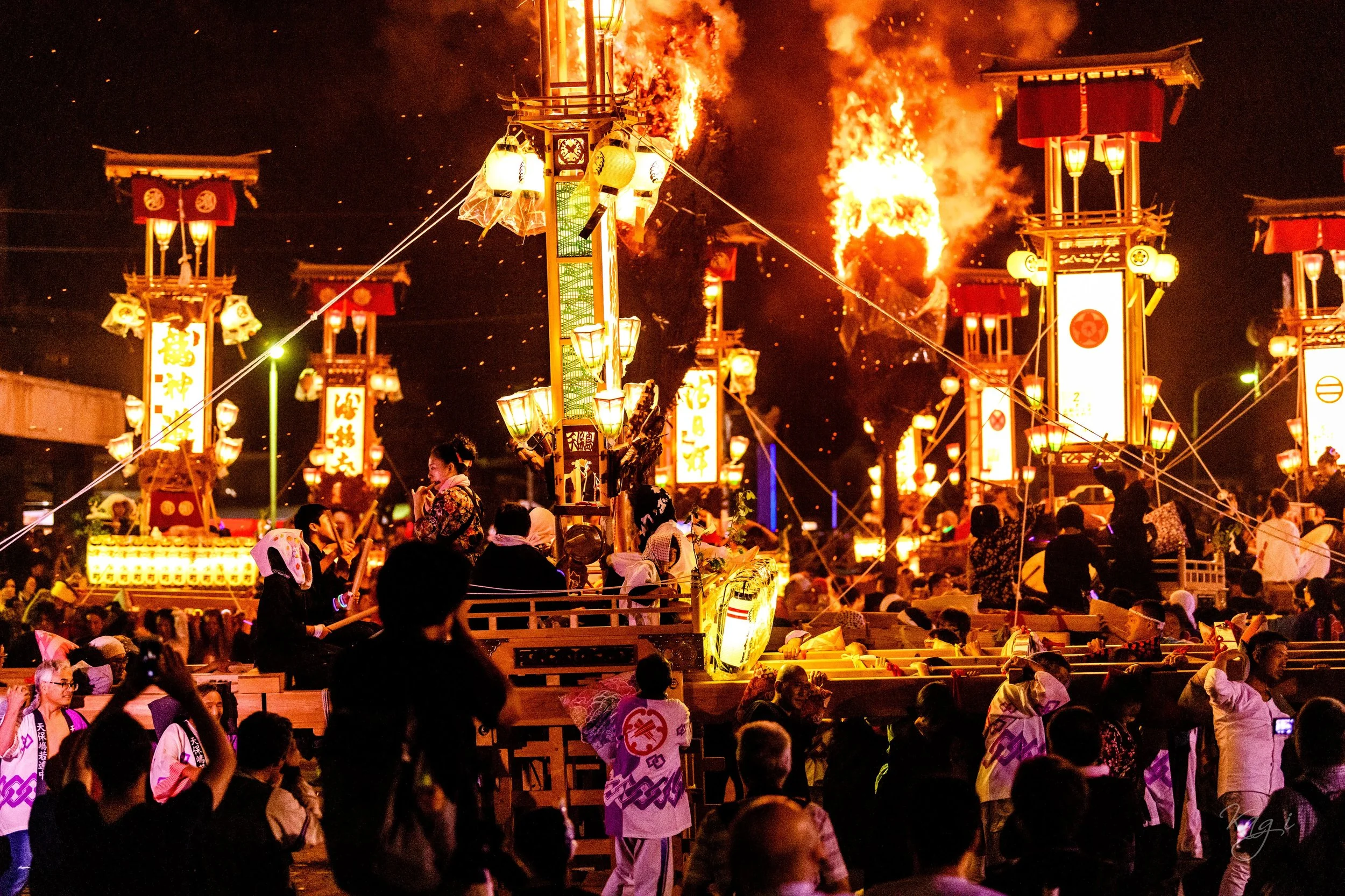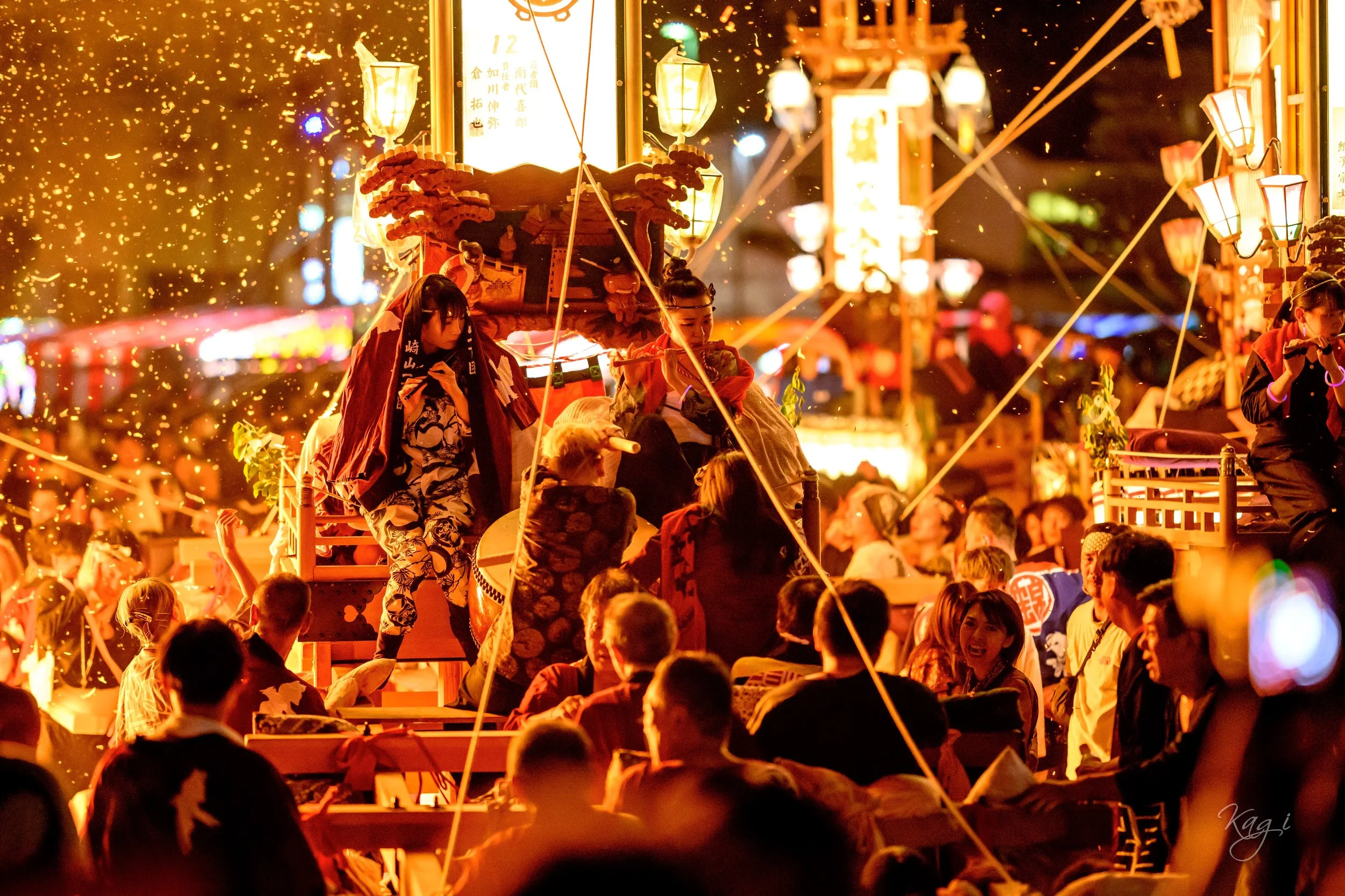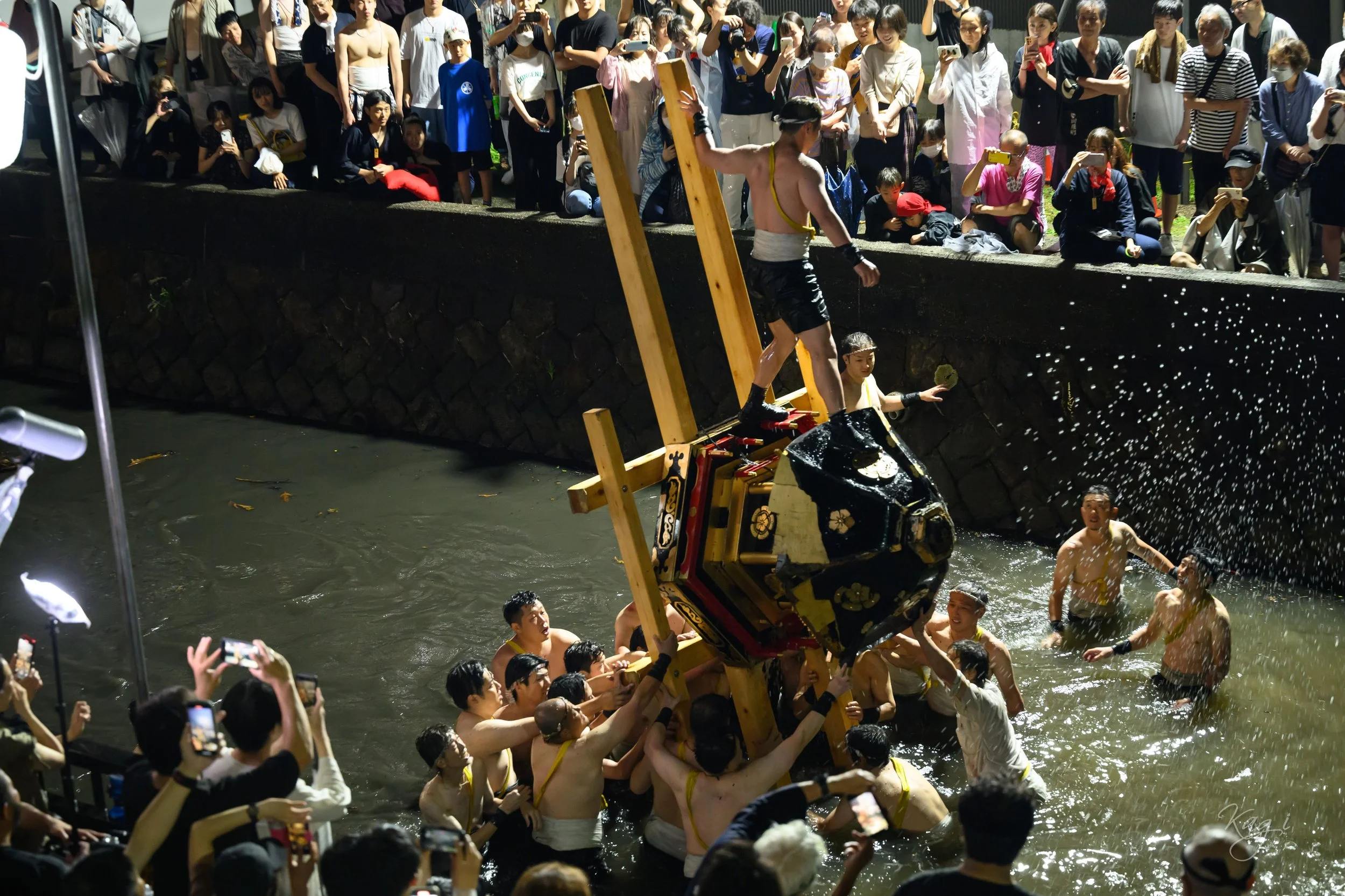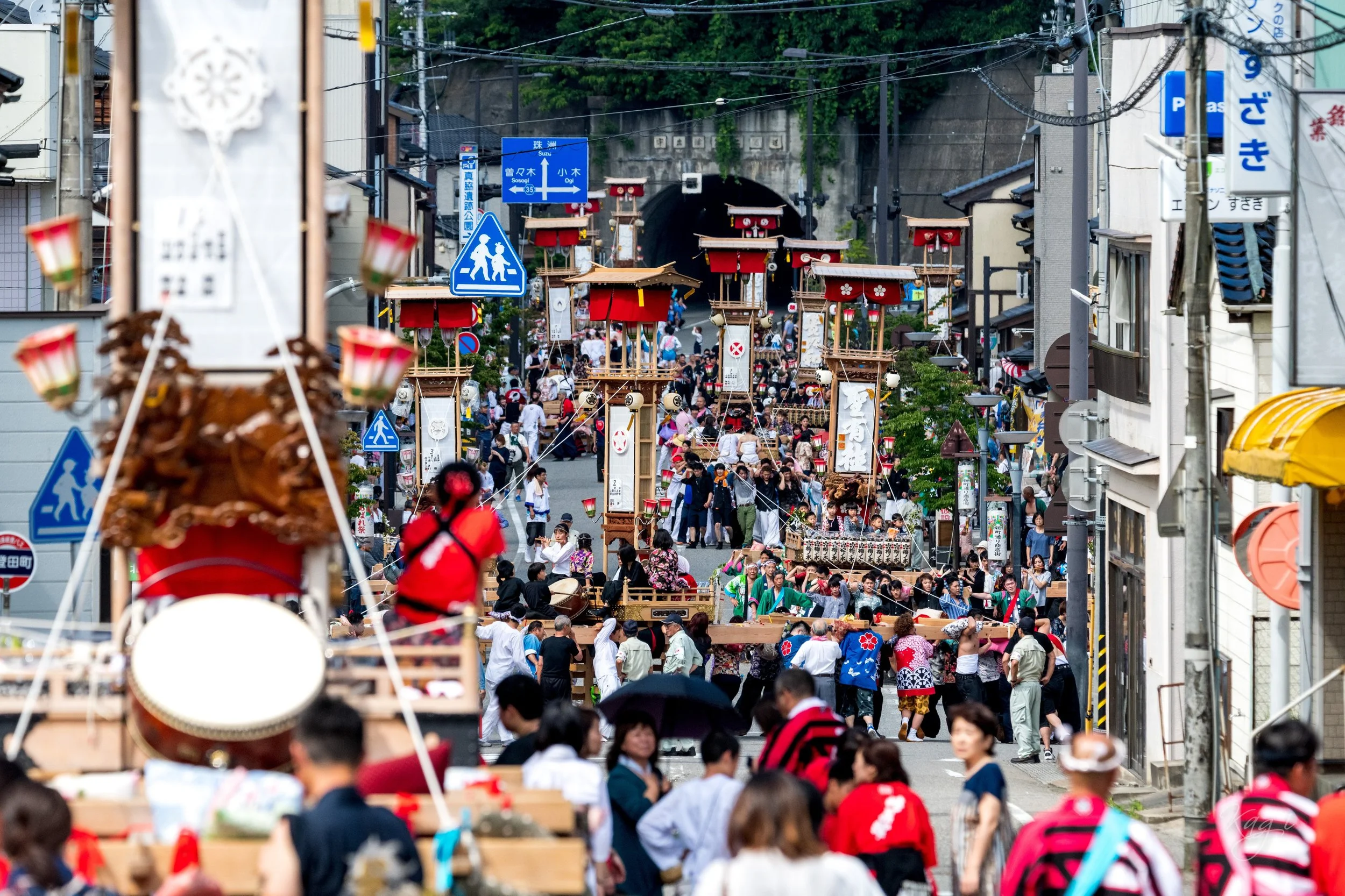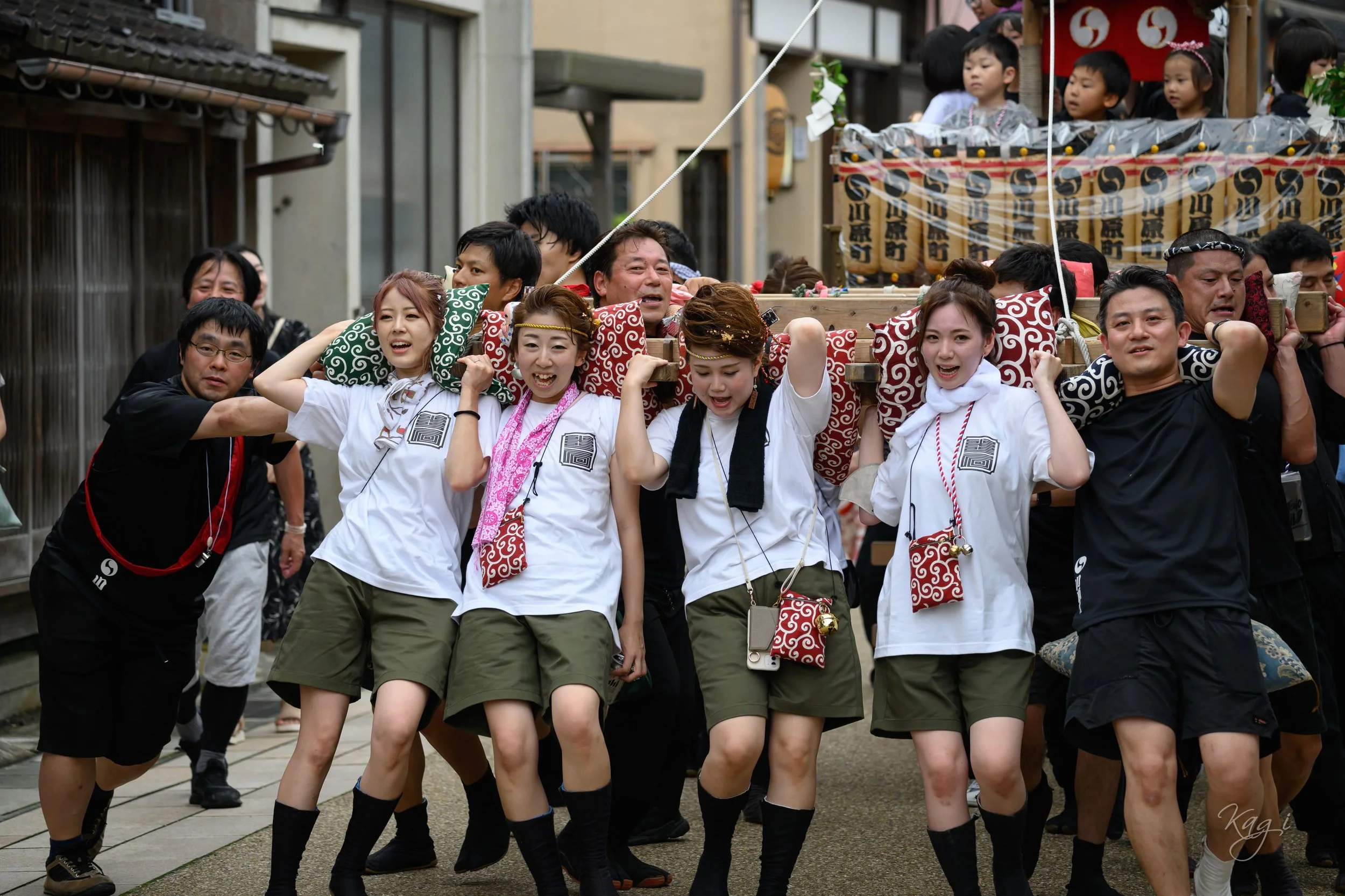From Epidemic to Extravaganza:
The Abare Matsuri Story
Photo courtesy of Tetsu Kaginushi 撮影 鍵主 哲
The Abare Matsuri, is an annual event held in the small town of Ushitsu in Ishikawa Prefecture, Japan. If you’ve ever wanted to witness something that feels like it’s straight out of a movie—chaotic, intense, and utterly unforgettable—this is it.
About 350 years ago, during the Kanbun era (1661–1672), a devastating disease swept through the area. In desperation, the locals brought Gozu Tenno, a deity from Gion Shrine in Kyoto, and initiated a festival. Legend has it that a blue bee, filled with the god's power, appeared and cured the sick.
Overjoyed, the people carried large Kiriko lanterns to Yasaka Shrine in gratitude, marking the start of the Abare Festival.
Today, around 40 Kiriko, each standing 7 meters tall, parade through the town. Two Mikoshi (portable shrines) are shaken and thrown into the sea, rivers, and even set on fire. This energetic festival is now celebrated as one of the most famous sea festivals in the Noto region.
Fast forward to today, and the Abare Matsuri is still going strong. It’s a two-day event in early July, and the second day is when things really heat up—literally. Picture this: hundreds of guys in loincloths, carrying these huge, ornate shrines through the streets. But wait, it gets better. These shrines are fitted with massive flaming torches, and the bearers are crashing them into each other, into the ground, and even into the sea. It’s like a mix of a parade, a wrestling match, and a bonfire party, all rolled into one.
The Legend and Lore of Abare-Mikoshi:
One of the most fascinating parts of Abare Matsuri is the local belief that if the wild abare-mikoshi shrine doesn't get paraded through the fields, the harvest will fail, and people might get sick if they don't lend a hand. Legend has it that one year they skipped the parade, and an epidemic hit the village—creepy, right?
The festival starts with Shinto priests carrying the main hon-mikoshi shrine, while the abare-mikoshi is hauled by young guys in ragged farming clothes with bold face paint. Things start to get really crazy as these guys start shouting 'a~mottainai mottainai' ('What a waste!') and even pull people out of a pond! The unique costumes, the makeup, and the whole pond-chasing tradition make this festival something you won't forget.
As the night goes on, things reach an insane climax of destruction and renewal. From 9 pm until dawn, the two mikoshi shrines are slammed onto the ground, thrown into the river, and even into the fire by frenzied participants until they're completely destroyed. This intense and dramatic ritual has been going on for 350 years, symbolizing purification and the washing away of bad luck. Watching the mikoshi being destroyed is the highlight of Abare Matsuri, embodying the festival's wild and chaotic spirit.
Why Is It So Wild?
The whole point of the festival is purification and renewal. The fire is supposed to cleanse everything, and the water (from dunking the shrines in the sea) washes away all the bad stuff. It’s a Shinto thing, all about harmony with nature and starting fresh. But honestly, it’s also about showing off some serious strength and teamwork.
Carrying those mikoshi is no joke. They weigh a ton, and the guys have to navigate narrow streets, steep hills, and a crowd that’s just as fired up as they are. It’s a test of endurance, but it’s also a huge bonding experience for the community. Young guys, old guys—everyone comes together to keep this tradition alive.
Where to Stay: Hyakurakuso, the Inn with the Cave Bath
Now, if you’re going to all the trouble of traveling to Ishikawa for this festival, you might as well stay somewhere cool, right? Enter Hyakurakuso, a ryokan (that’s a traditional Japanese inn) on the Noto Peninsula. This place is not your average hotel.
First off, it has the only hand-carved cave bath in Japan. Yes, you read that right—a cave bath. It was carved by a master stonemason, and it’s this incredible mix of natural rock and artistry. The bath is softly lit, so it feels like you’re soaking in some kind of mystical underground sanctuary. It’s the perfect way to unwind after a day of festival chaos.
The rooms at Hyakurakuso are just as amazing. They’re super luxurious but still have that traditional Japanese vibe, with tatami mats and sliding paper doors. Oh, and the views? Stunning. You can look out over Tsukumo Bay while sipping on some local sake. Speaking of which, the food here is next-level. They serve these elaborate kaiseki meals with fresh seafood and seasonal ingredients. It’s like a fancy tasting menu, but with a side of Japanese culture.
How Far is Hyakurakuso from the Festival?
Hyakurakuso is located on the Noto Peninsula, about 30 kilometers (18 miles) from Ushitsu, where the Abare Matsuri takes place. The drive takes roughly 40 minutes, making it a convenient base for attending the festival. After a day of fiery chaos, you can retreat to the serene luxury of the ryokan and soak in the cave bath while reflecting on the incredible experience.
Meet the Kiriko Float Makers
While you’re in the area, don’t miss the chance to meet the local artisans who create the kiriko lantern floats used in the Abare Matsuri. These massive, intricately designed floats are a sight to behold, and the craftsmen behind them are true masters of their trade.
You can visit the Wajima Kiriko Hall, about an hour’s drive from Ushitsu, to see the floats up close and even meet the artisans. Some workshops also offer hands-on experiences, where you can try your hand at traditional crafts like lacquerware or wood carving. It’s a unique opportunity to connect with the culture and take home a piece of Noto’s heritage.
Website: Wajima Kiriko Art Museum
Final Thoughts
The Abare Matsuri is a festival where fire meets water, tradition meets chaos, and you can witness something truly extraordinary. Hyakurakuso is the perfect home base for your adventure. So, if you’re looking for a trip that’s equal parts thrilling and relaxing, start planning your visit to Ishikawa. Just don’t forget to pack your sense of adventure—and maybe a fire extinguisher, just in case.
Special thanks to Mr. Morozumi from Yasaka Jinja Hosankai for his support in writing this post.
Website: Abare Matsuri (Japanese only)
All photos generously supplied by Tetsu Kaginushi 撮影 鍵主 哲
The Noto Peninsula, known for its vibrant festivals like the Abare Matsuri, faced a tough challenge with the 7.6-magnitude earthquake on January 1, 2024. The quake caused significant damage, including collapsed buildings, fires, and tsunamis, and the region is still recovering. Despite these difficulties, the community has shown remarkable resilience. Visiting the Noto Peninsula isn't just about enjoying its unique culture and beautiful landscapes; it's also a way to support a community that's been through a lot. Your visit can make a real difference, so consider planning a trip to experience the charm of this special place firsthand.
